A Study of the Laser Removal Process of Al-Si Coating from 22MnB5 Steel
Abstract
:1. Introduction
2. Experimental Procedure
3. Results and Discussion
3.1. The Laser Decoating Process
3.2. Effect of Laser Decoating Width on the Welded Joints
4. Conclusions
- (1)
- High-power picosecond lasers are more effective for removing coating than low-power sub-nanosecond lasers. Under the removal parameters of 1064 nm center wavelength, 15 kW power, 100 kHz frequency and 0.1 m/s speed, the mechanical properties of the welded joint meet the application requirements.
- (2)
- The content of coating metal elements (mainly Al) melted into the welded joint is reduced with the increasing coating removal width, which can significantly improve the mechanical properties of the welded joints.
- (3)
- The Al element of the coating rarely melts into the melt pool when the coating removal width is not less than 0.4 mm, and its mechanical properties can meet automotive stamping requirements.
Author Contributions
Funding
Data Availability Statement
Conflicts of Interest
References
- Xu, W.; Westerbaan, D.; Nayak, S.S.; Chen, D.L.; Goodwin, F.; Zhou, Y. Tensile and fatigue properties of fiber laser welded high strength low alloy and DP980 dual-phase steel joints. Mater. Des. 2013, 43, 373–383. [Google Scholar] [CrossRef]
- Chen, H.C.; Era, H.; Shimizu, M. Effect of phosphorus on the formation of retained austenite and mechanical properties in Si-containing low-carbon steel sheet. Metall. Trans. A 1989, 20, 437–445. [Google Scholar] [CrossRef]
- Kim, C.; Kang, M.J.; Park, Y.D. Laser welding of Al-Si coated hot stamping steel. Procedia Eng. 2011, 10, 2226–2231. [Google Scholar] [CrossRef]
- Tang, B.; Yuan, Z.; Cheng, G.; Huang, L.; Zheng, W.; Xie, H. Experimental verification of tailor welded joining partners for hot stamping and analytical modeling of TWBs rheological constitutive in austenitic state. Mater. Sci. Eng. A 2013, 585, 304–318. [Google Scholar] [CrossRef]
- Karbasian, H.; Tekkaya, A.E. A review on hot stamping. J. Mater. Process. Technol. 2010, 210, 2103–2118. [Google Scholar] [CrossRef]
- Bleck, W.; Brühl, F.; Ma, Y.; Sasse, C. Materials and Processes for the Third-generation Advanced High-strength Steels. BHM Berg.-Hüttenmännische Mon. 2019, 164, 466–474. [Google Scholar] [CrossRef]
- Billur, E. Hot formed steels. In Automotive Steels; Elsevier: Amsterdam, The Netherlands, 2017; pp. 387–411. [Google Scholar]
- Lin, W.; Li, F.; Hua, X.; Zhang, Z. Laser welding Al–Si coated hot stamping steel in conduction mode: Weld formation and Al-rich microstructure. J. Mater. Res. Technol. 2022, 19, 4282–4295. [Google Scholar] [CrossRef]
- Yoon, T.-J.; Oh, M.-H.; Shin, H.-J.; Kang, C.-Y. Comparison of microstructure and phase transformation of laser-welded joints in Al-10wt%Si-coated boron steel before and after hot stamping. Mater. Charact. 2017, 128, 195–202. [Google Scholar] [CrossRef]
- Lin, W.; Li, F.; Wu, D.; Chen, X.; Hua, X.; Pan, H. Effect of Al-Si Coating on Weld Microstructure and Properties of 22MnB5 Steel Joints for Hot Stamping. J. Mater. Eng. Perform. 2018, 27, 1825–1836. [Google Scholar] [CrossRef]
- Kang, M.; Kim, C. Laser welding for hot-stamped tailor-welded blanks with high-strength steel/high-energy absorption steel. J. Laser Appl. 2014, 26, 032007. [Google Scholar] [CrossRef]
- Wang, X.; Yi, G.; Sun, Q.; Xiao, M.; Gao, Y.; Zhang, Z.; Di, H.; Zhou, Y. Study on δ-ferrite evolution and properties of laser fusion zone during post-weld heat treatment on Al-Si coated press-hardened steel. J. Mater. Res. Technol. 2020, 9, 5712–5722. [Google Scholar] [CrossRef]
- Norman, P.; Wiklund, G.; Janiak, P.; Kaplan, A. Comparison of 22MnB5-steel with and without AlSi-coating during laser hybrid arc welding. In Proceedings of the 13th Conference on Laser Materials Processing in the Nordic Countries, Trondheim, Norway, 27–29 June 2011; pp. 21–30. [Google Scholar]
- Kang, M.; Kim, C.; Lee, J. Weld strength of laser-welded hot-press-forming steel. J. Laser Appl. 2012, 24, 022004. [Google Scholar] [CrossRef]
- Moon, J.-H.; Seo, P.-K.; Kang, C. A study on mechanical properties of laser-welded blank of a boron sheet steel by laser ablation variable of Al-Si coating layer. Int. J. Precis. Eng. Manuf. 2013, 14, 283–288. [Google Scholar] [CrossRef]
- Kang, M.; Kim, C.; Bae, S.M. Laser tailor-welded blanks for hot-press-forming steel with arc pretreatment. Int. J. Automot. Technol. 2015, 16, 279–283. [Google Scholar] [CrossRef]
- Vierstraete, R.; Ethling, W.; Pinard, F.; Cretteur, L.; Pic, A.; Yin, Q. Laser ablation for hardening laser welded steel blanks. Ind. Laser Solut. Manuf. 2010, 25, 6–11. [Google Scholar]
- Li, F.; Chen, X.; Lin, W.; Pan, H.; Jin, X.; Hua, X. Nanosecond laser ablation of Al-Si coating on boron steel. Surf. Coat. Technol. 2017, 319, 129–135. [Google Scholar] [CrossRef]
- Sun, J.; Han, Z.; Xu, F.; Wang, X.; Cui, H.; Lu, F. The segregation control of coating element for pulse fiber laser welding of Al-Si coated 22MnB5 steel. J. Mater. Process. Technol. 2020, 286, 116833. [Google Scholar] [CrossRef]
- Xu, W.; Yang, S.; Tao, W.; Zhang, J.; Luo, H. Effect of Al-Si Coating Removal State on Microstructure and Mechanical Properties of Laser Welded 22MnB5 Steel. J. Mater. Eng. Perform. 2022, 1–11. [Google Scholar] [CrossRef]
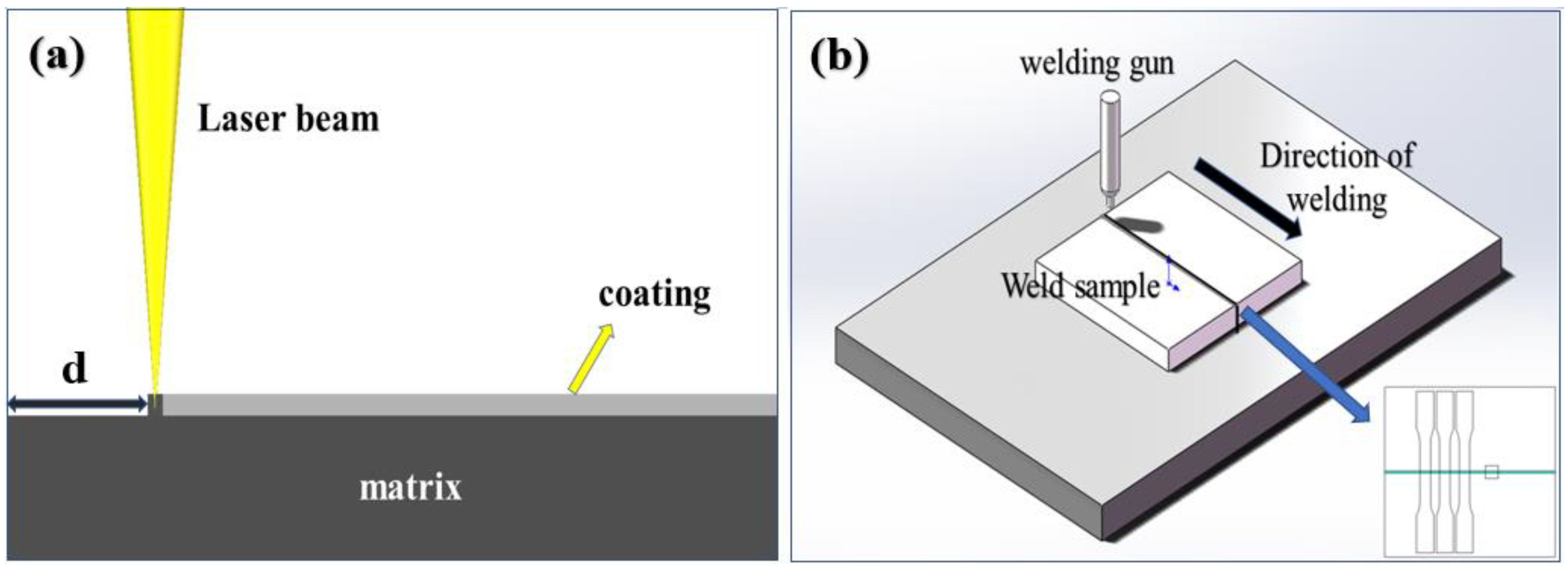


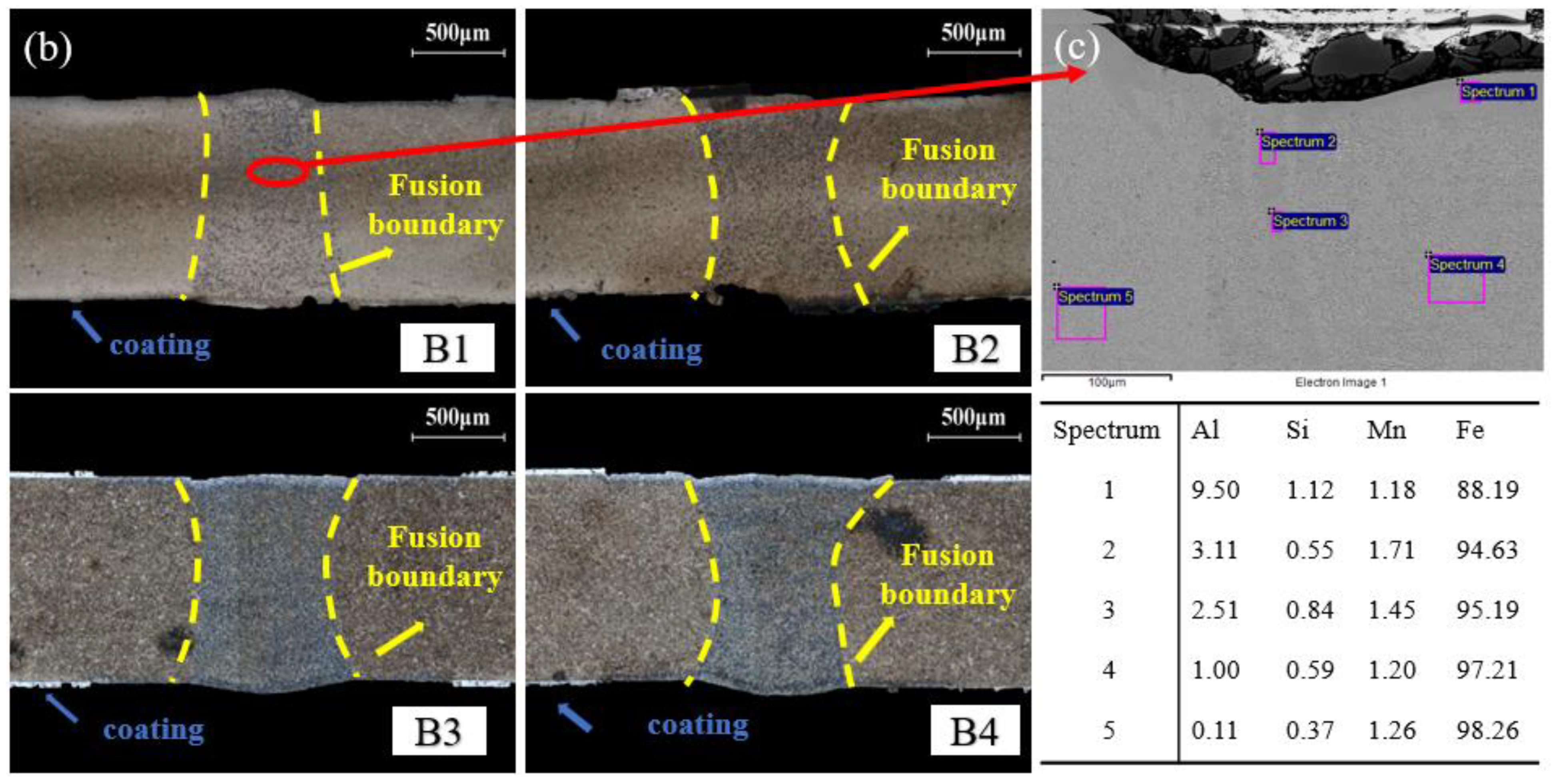
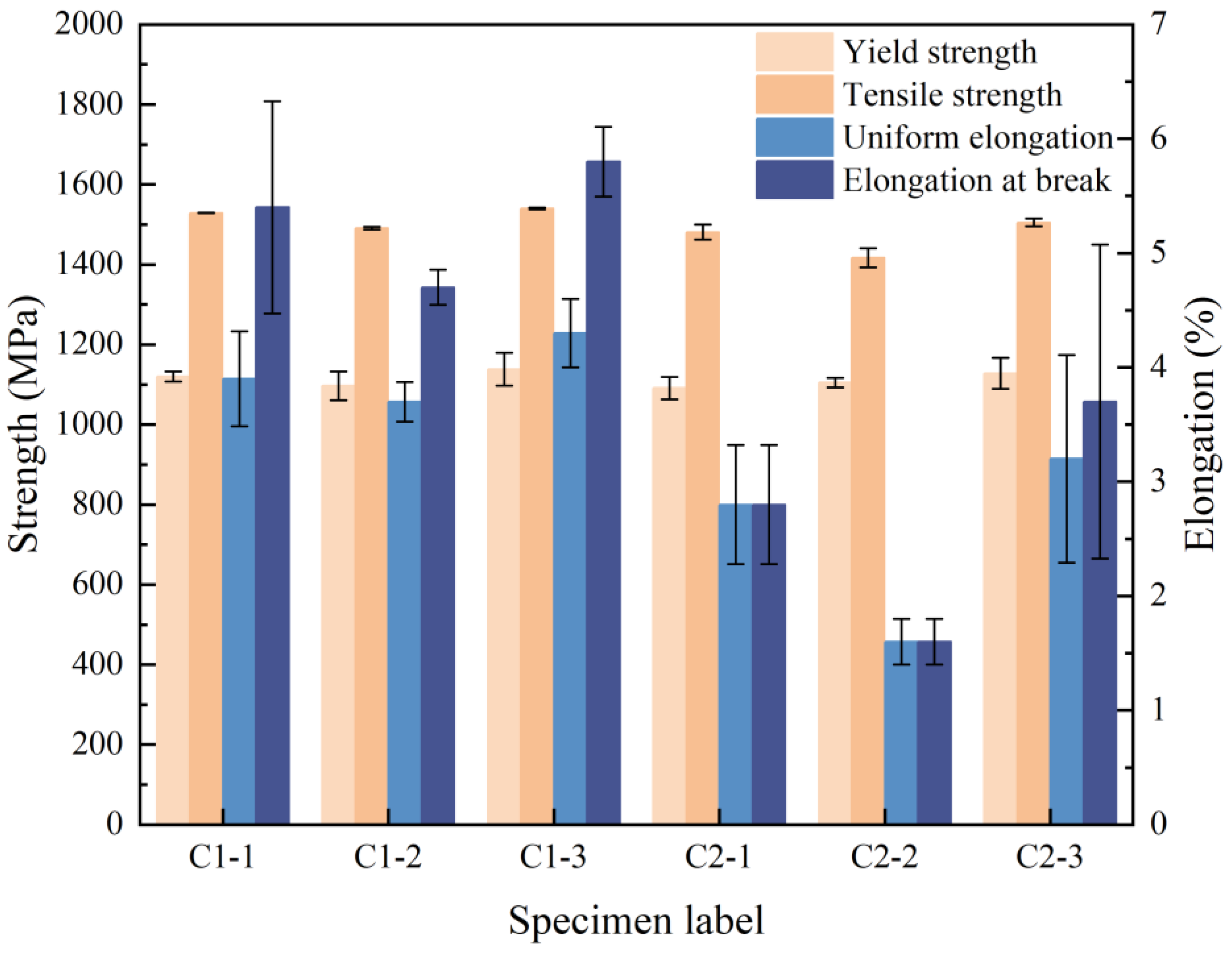
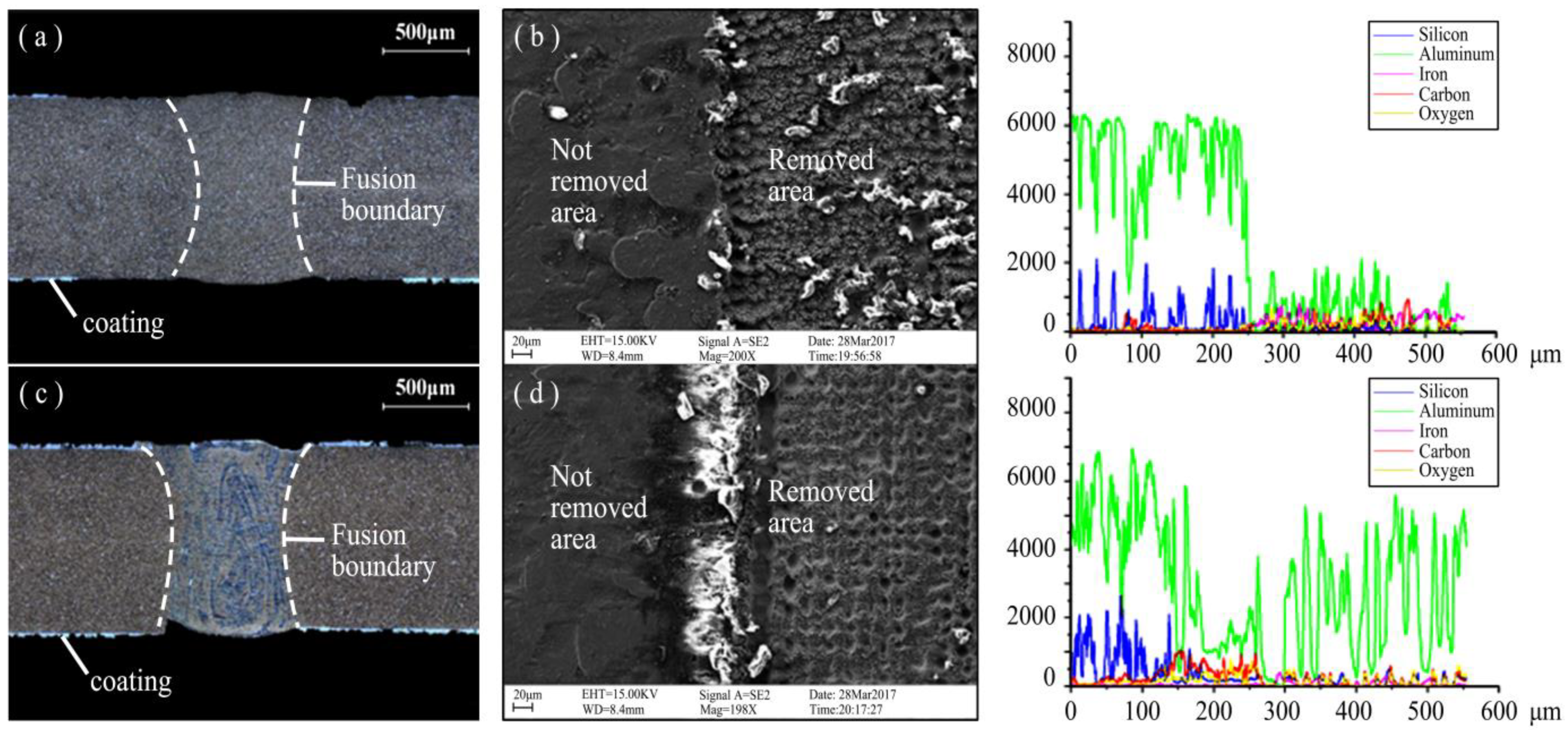



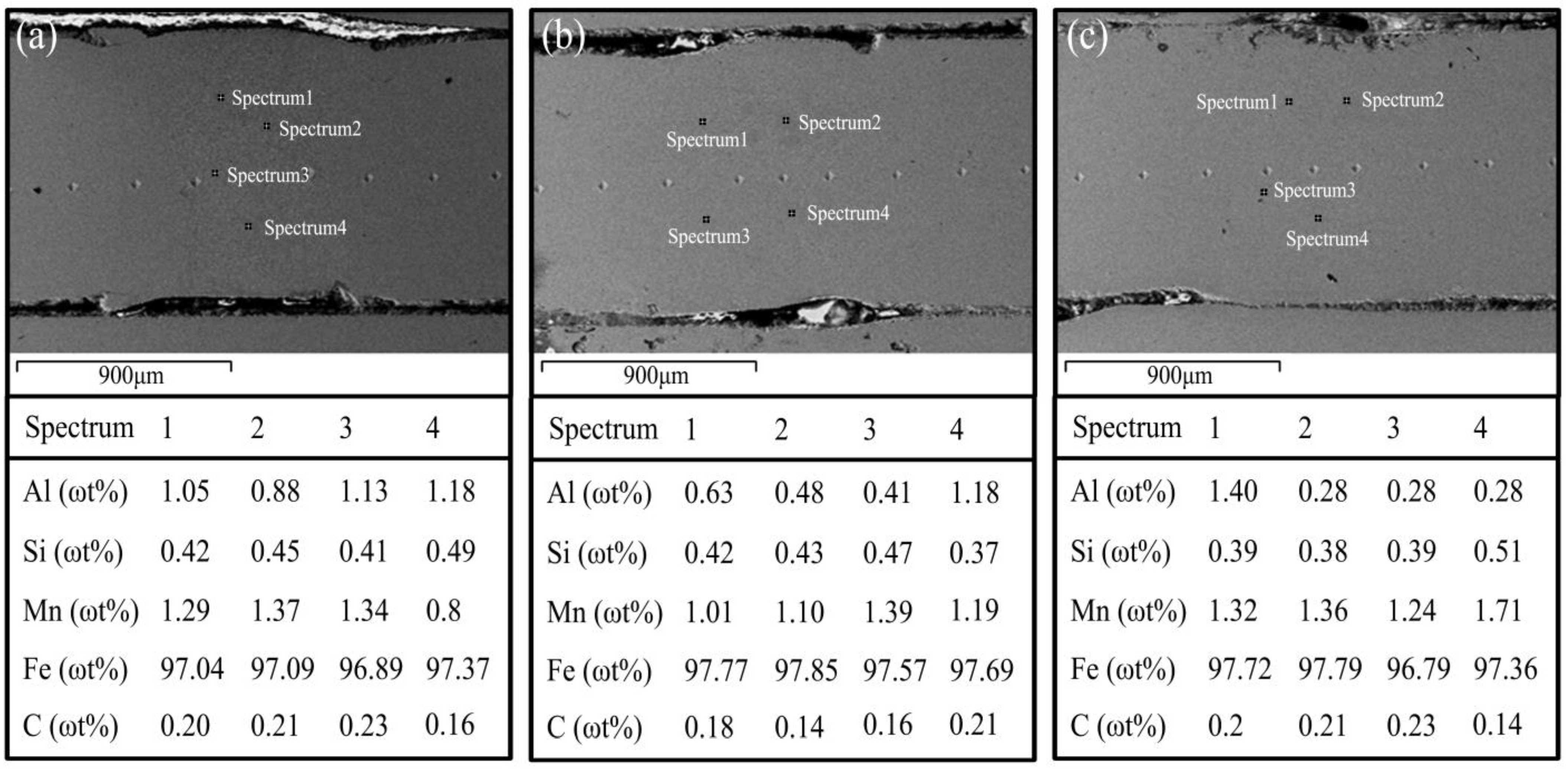
| C | Si | Mn | Al | Ti | Cr | B | Fe |
|---|---|---|---|---|---|---|---|
| 0.22 | 0.27 | 1.12 | 0.035 | 0.004 | 0.15 | 0.018 | Bal. |
| Parameter Lasers | Center Wavelength | Average Power | Repetition Frequency | Pulse Energy | Peak Power | Pulse Width |
|---|---|---|---|---|---|---|
| Sub-nanosecond | 1064 nm | 50 W | 50 kHz | 1 mJ | 10 kW | 100 ns |
| Picosecond | 1064 nm | 100 W | 400 kHz | 250 μJ | 31.25 mW | 8~10 ps |
| No. | HF | LF | No. | HF | LF | No. | HF | LF |
|---|---|---|---|---|---|---|---|---|
| A1-1 | 2 | 1 | A2-1 | 3 | 1 | A3-1 | 4 | 1 |
| A1-2 | 3 | 1 | A2-2 | 3 | 2 | A3-2 | 4 | 2 |
| A1-3 | 4 | 1 | A2-3 | 3 | 3 | A3-3 | 4 | 3 |
| A1-4 | 5 | 1 | A2-4 | 3 | 4 | A3-4 | 4 | 4 |
| A1-5 | 6 | 1 | A2-5 | 3 | 5 | A3-5 | 4 | 5 |
| A1-6 | 7 | 1 | A2-6 | 3 | 6 | A3-6 | 4 | 6 |
| A1-7 | 8 | 1 | A2-7 | 3 | 7 | A3-7 | 4 | 7 |
| A1-8 | 9 | 1 | A2-8 | 3 | 8 | A3-8 | 4 | 8 |
| No. | Average Power | Frequency | Speed | Times | Function |
|---|---|---|---|---|---|
| C1 | 15 W | 100 kHz | 0.1 m/s | 1 | removal |
| C2 | 12.5 W | 100 kHz | 0.3 m/s | 2 | removal |
| 10 W | 100 kHz | 1 m/s | 1 | cleaning |
Disclaimer/Publisher’s Note: The statements, opinions and data contained in all publications are solely those of the individual author(s) and contributor(s) and not of MDPI and/or the editor(s). MDPI and/or the editor(s) disclaim responsibility for any injury to people or property resulting from any ideas, methods, instructions or products referred to in the content. |
© 2023 by the authors. Licensee MDPI, Basel, Switzerland. This article is an open access article distributed under the terms and conditions of the Creative Commons Attribution (CC BY) license (https://creativecommons.org/licenses/by/4.0/).
Share and Cite
Zhang, T.; Xu, J.; Lin, S.; Yu, W.; Chen, Y. A Study of the Laser Removal Process of Al-Si Coating from 22MnB5 Steel. Materials 2023, 16, 3709. https://doi.org/10.3390/ma16103709
Zhang T, Xu J, Lin S, Yu W, Chen Y. A Study of the Laser Removal Process of Al-Si Coating from 22MnB5 Steel. Materials. 2023; 16(10):3709. https://doi.org/10.3390/ma16103709
Chicago/Turabian StyleZhang, Tao, Jihao Xu, Shuxia Lin, Wangwang Yu, and Yong Chen. 2023. "A Study of the Laser Removal Process of Al-Si Coating from 22MnB5 Steel" Materials 16, no. 10: 3709. https://doi.org/10.3390/ma16103709





